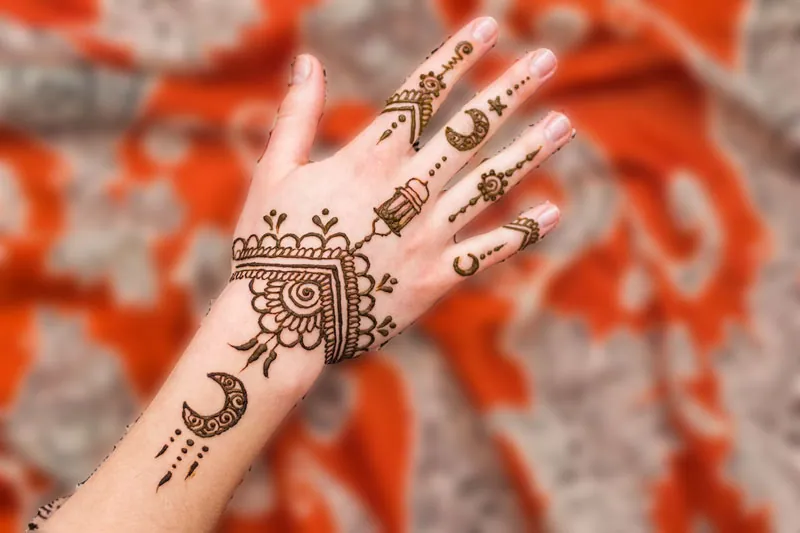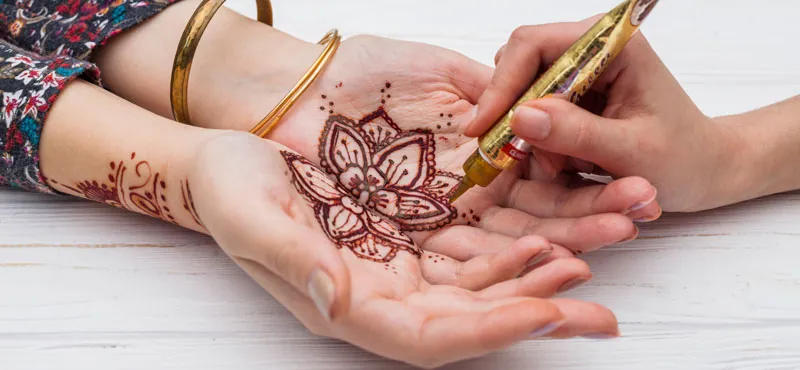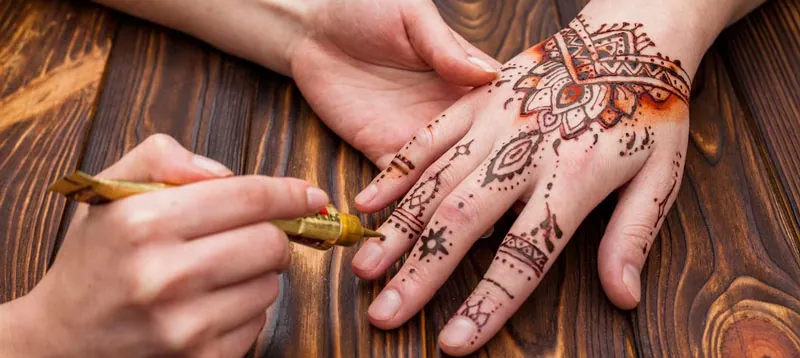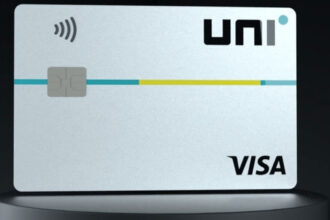Simple Mehndi Design Arabic Very easy: Mehndi, also known as henna, is a natural dye made from the leaves of the henna plant. Mehndi has been used for centuries in various cultures to adorn the hands and feet with intricate designs. Mehndi is not only a beautiful form of body art but also has cultural and religious significance in many parts of the world. In this article, we will discuss the history of Mehndi, different types of Mehndi designs, and the significance of Mehndi in various cultures.
- History of Mehndi
- The Art of Mehndi Design
- Modern-Day Applications of Mehndi Design
- Mehndi Design: A Cultural Symbol
- Different Types of Mehndi Designs
- Indian Mehndi Designs
- Pakistani Mehndi Designs
- Arabic Mehndi Designs
- African Mehndi Designs
- Western Mehndi Designs
- Significance of Mehndi in Various Cultures
- Tips for Applying Mehndi
- Mehndi Design: FAQs
History of Mehndi
Mehndi has a rich history that dates back to ancient times. It is believed that the use of mehndi originated in ancient Egypt, where it was used to dye the hair and nails of the pharaohs. Mehndi then spread to other parts of the world, including India, Pakistan, and the Middle East, where it became an important part of cultural and religious ceremonies.
In addition to India, Mehndi is also an integral part of other cultures, including those of Pakistan, Bangladesh, and the Middle East. Today, Mehndi’s design has evolved into a popular form of body art that is embraced by people of all cultures and backgrounds.
The Art of Mehndi Design
Mehndi design is an intricate art that requires a great deal of skill and creativity. The designs are created using a paste made from henna leaves, which is applied to the skin using a cone or a brush. The paste is left on the skin for several hours until it dries, after which it is removed, revealing a beautiful, reddish-brown design.

There are many different types of Mehndi designs, each with its own unique style and pattern. Some of the most popular designs include Arabic Mehndi, Indian Mehndi, Pakistani Mehndi, and Moroccan Mehndi. Each of these designs has its own distinct characteristics, such as the use of geometric shapes, floral patterns, or intricate motifs.
Modern-Day Applications of Mehndi Design
In recent years, Mehndi design has become increasingly popular as a form of fashion and body art. Today, people of all ages and backgrounds are embracing this ancient tradition, and Mehndi design is now commonly seen at weddings, festivals, and other special events.

In addition to being a popular form of body art, Mehndi design also has a range of other applications. For example, Mehndi is often used as a natural hair dye and as a form of alternative medicine. The leaves of the henna plant are believed to have cooling and anti-inflammatory properties, and they are sometimes used to treat skin conditions such as eczema and psoriasis.
Mehndi Design: A Cultural Symbol
Mehndi design is not just a form of body art; it is also a symbol of cultural identity. In many cultures, Mehndi is seen as a way of celebrating tradition and expressing cultural pride. For example, in India, Mehndi is an integral part of wedding ceremonies, and the intricate designs are seen as a symbol of good luck and prosperity. In Pakistan, Mehndi is also an essential part of wedding celebrations, and the designs are seen as a way of celebrating the bride’s beauty and femininity.
Different Types of Mehndi Designs
Mehndi designs vary depending on the culture and occasion. Here are some of the most popular types of mehndi designs:
Indian Mehndi Designs
Indian mehndi designs are intricate and detailed. They often feature peacocks, flowers, and other traditional Indian motifs. Indian brides typically have mehndi applied to their hands and feet before their wedding day.
Pakistani Mehndi Designs
Pakistani mehndi designs are similar to Indian mehndi designs but have a distinct style. Pakistani mehndi designs often feature geometric shapes and patterns.
Arabic Mehndi Designs
Arabic mehndi designs are bold and simple. They often feature large floral patterns and geometric shapes. Arabic mehndi designs are popular in the Middle East and North Africa.
African Mehndi Designs
African mehndi designs are similar to Arabic mehndi designs but have a unique style. African designs often feature bold, tribal patterns and are popular in parts of Africa.
Western Mehndi Designs
Western mehndi designs are a fusion of traditional mehndi designs with modern elements. Western mehndi designs often feature abstract patterns and are popular in Western countries.
Significance of Mehndi in Various Cultures
Mehndi has cultural and religious significance in many parts of the world. Here are some of the ways mehndi is used in different cultures:
Indian Culture
In Indian culture, mehndi is an important part of weddings and other celebrations. Indian brides typically have mehndi applied to their hands and feet before their wedding day. Mehndi is also used in other celebrations, such as Diwali and Karva Chauth.
Pakistani Culture
In Pakistani culture, mehndi is used in weddings and other celebrations. Mehndi is also used during Eid, a Muslim holiday.
Middle Eastern Culture
In Middle Eastern culture, mehndi is used in weddings and other celebrations. Mehndi is also used during Eid al-Fitr, a Muslim holiday.
African Culture
In African culture, mehndi is used for cosmetic purposes and is believed to have healing properties.
Tips for Applying Mehndi
If you want to try applying mehndi yourself, here are some tips:
- Start with a simple design before attempting more complex designs. This will help you get familiar with the mehndi application process and improve your skills gradually.
- Use a cone or a mehndi pen to apply the mehndi. These tools give you more control over the flow of the mehndi and allow you to create more intricate designs.
- Let the mehndi dry completely before removing it. This can take several hours, so plan accordingly.
- Apply lemon juice or sugar water to the dried mehndi to help set the color. You can also use a mixture of sugar and water to apply to the mehndi after it has dried.
- Avoid getting the mehndi wet for at least 12 hours after application. This will help the color set and last longer.
With these tips in mind, you can create beautiful mehndi designs on your hands and feet. Remember to be patient and take your time, as applying mehndi can be a time-consuming process.

Join Mehndi Design Telegram Channel
Also Read…
- Adipurush Movie Download & Release Date review 2025 in 720p 480p 300MB
- MovieRulz 2024 APK Movies Download Latest Kannada Telugu etc
- Virupaksha Download Movie [4K, HD, 1080p 480p, 720p] Review
- Ponniyin Selvan 2 Movie Download Filmyzilla 300MB, 360p, & 720p Review
- Saas Bahu Aur Flamingo download [4K, HD, 1080p 480p, 720p] Review
- The Kerala Story Movie Download [4K, HD, 1080p 480p, 720p] Review
- The Kerala Story Download Movie in 300MB and 700MB
- Bhediya Download [4K, HD, 1080p 480p, 720p] Review
- Afwaah Movie Download 300MB, 360P & 1020P Filim Review
- United Kacche Download 300MB, 360p, 720p Web Series Review
Mehndi Design: FAQs
How long does Mehndi last?
Mehndi typically lasts for 1-2 weeks, depending on the quality of the henna paste, the area of the body it is applied to, and how well it is cared for. To make the design last longer, it is recommended to keep the skin moisturized and avoid excessive exposure to water.
Is Mehndi safe for the skin?
Yes, Mehndi is generally considered safe for the skin. However, it is important to use high-quality henna paste and to avoid black henna, which can cause allergic reactions and other skin problems. It is also recommended to do a patch test before applying Mehndi to the entire body.
Can children get Mehndi designs?
Yes, children can get Mehndi designs. However, it is recommended to use natural henna paste and to avoid applying it to sensitive areas such as the face and eyes. It is also important to supervise children during the application process to prevent them from accidentally ingesting the paste.
Can Mehndi be removed if I don’t like the design?
Yes, Mehndi can be removed if you don’t like the design or if it is applied incorrectly. There are several methods for removing Mehndi, including using lemon juice, baking soda, or a commercial henna removal solution. It is important to note that Mehndi may leave a stain on the skin even after it has been removed.
What is the significance of Mehndi in Indian weddings?
In Indian weddings, Mehndi is applied to the hands and feet of the bride as a way of celebrating her beauty and femininity. It is also believed to bring good luck and prosperity to the couple. Mehndi is often applied during a pre-wedding ceremony called the Mehndi ceremony, which is a festive and joyous occasion.
Can I create my own Mehndi design?
Yes, you can create your own Mehndi design. There are many resources available online, including tutorials and design templates, that can help you create a unique and beautiful design. It is important to practice on a small area of the body before attempting a larger design and to use high-quality henna paste and tools.
Mehndi design, also known as henna art, is a traditional form of body art that has been practiced for centuries. This ancient art form originated in India, but it has since spread across the globe, becoming a popular fashion trend and a symbol of cultural identity. Mehndi is derived from the Sanskrit word ‘mehndika’, which means ‘henna plant’. The leaves of this plant are used to create a paste that is applied to the skin to create intricate designs. In this article, we will delve deeper into the world of Mehndi design and explore its rich history, cultural significance, and modern-day applications.



